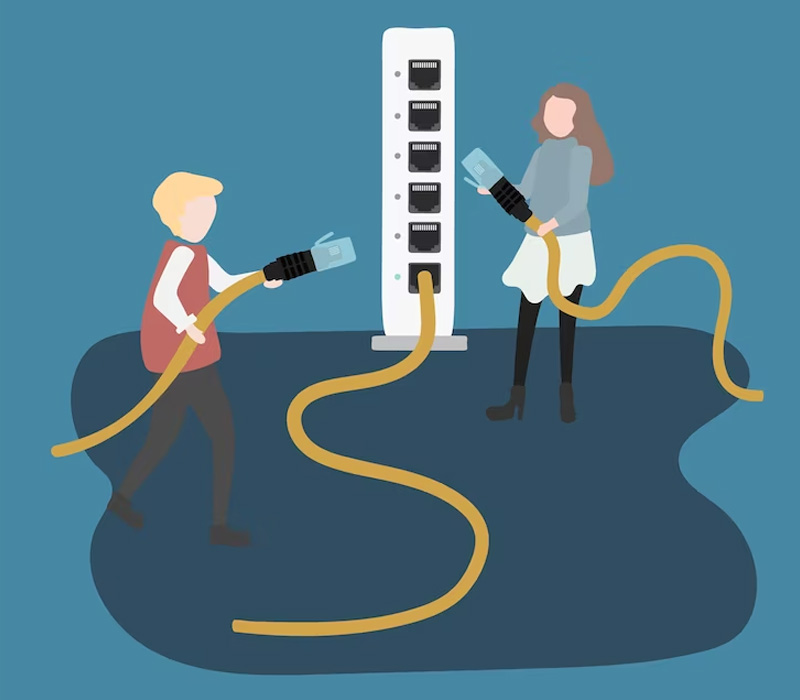
In internetworking, the process of moving a packet of data from source to destination. Routing is usually performed by a dedicated device called a router. Routing is a key feature of the Internet because it enables messages to pass from one computer to another and eventually reach the target machine. Each intermediary computer performs routing by passing along the message to the next computer. Part of this process involves analyzing a routing table to determine the best path.
Routing is often confused with bridging, which performs a similar function. The principal difference between the two is that bridging occurs at a lower level and is therefore more of a hardware function whereas routing occurs at a higher level where the software component is more important. And because routing occurs at a higher level, it can perform more complex analysis to determine the optimal path for the packet. A generic term that refers to a formula, or protocol, used by a router to determine the appropriate path over which data is transmitted. The routing protocol also specifies how routers in a network share information with each other and report changes. The routing protocol enables a network to make dynamic adjustments to its conditions, so routing decisions do not have to be predetermined and static
Routing switches are an innovative amalgam of two core networking devices, allowing them to achieve greater capability and performance. A routing switch can perform nearly all the same operations as a router and switch by transmitting data on LAN using Layer 2 switching techniques, and over distant LAN by integrating Layer 3 routing operative methods.
Routing switches were introduced into the market to improve the network traffic optimization in organizational wide LAN, which spread over many nodes and smaller LANs. The Layer 2 switches didn't provide the required efficiency in transferring data over largely dispersed LAN; therefore, Layer 3 switches not only manage the traffic within a single LAN segment, but they also provide optimal performance in managing and transporting data over distant corners of the LAN. Routing switches' hardware-powered routing capabilities provide for faster and better performance in a variety of scenarios. Routing switches can also be a cost-effective alternative to routers.
It’s a Network Packet switching is a digital network transmission process in which data is broken into suitably-sized pieces or blocks for fast and efficient transfer via different network devices. When a computer attempts to send a file to another computer, the file is broken into packets so that it can be sent across the network in the most efficient way. These packets are then routed by network devices to the destination.
There are two major modes of packet switching:
Each packet contains complete addressing or routing information and is routed individually. This can result in out-of-order delivery and different paths of transmission, depending on the variable loads on different network nodes (adapters, switches and routers) at any given time. Also known as datagram switching. In connectionless packet switching, each packet has the following information written in its header section:
After reaching the destination through different routes, the packets are rearranged to form the original message.
Data packets are sent sequentially over a predefined route. Packets are assembled, given a sequence number and then transported over the network to a destination in order. In this mode, address information is not required. Also known as virtual circuit switching.
In computer networking, a hop represents one portion of the full path between source and destination. When communicating over the Internet, for example, data passes through a number of intermediate devices (routers and switches) rather than flowing directly over a single wire. Each such device causes data to "hop" between one point-to-point network connection and another.
Computer and communication networks provide a wide range of services, from simple networks of computers to remote-file access to digital libraries, voice over IP (VoIP), Internet gaming, cloud computing, video streaming and conferencing, television over Internet, wireless data communication, and networking billions of users and devices. Before exploring the world of computer and communication networks, we need to study the fundamentals of packet-switched networks as the first step. Packet-switched networks are the backbone of the data communication infrastructure.
Therefore, our focus in this chapter is on the big picture and the conceptual aspects of this backbone highlighted as:
Routing & Switching Essentials (CCNA2) covers the architecture, components, and operations of routers and switches in a small network. Participants learn how to configure a router and a switch for basic functionality. By the end of this course, participants will be able to configure and troubleshoot routers and switches and resolve common issues with RIPv1, RIPv2, single area and multi-area OSPF, virtual LANs, and inter-VLAN routing in both IPv4 and IPv6 networks.